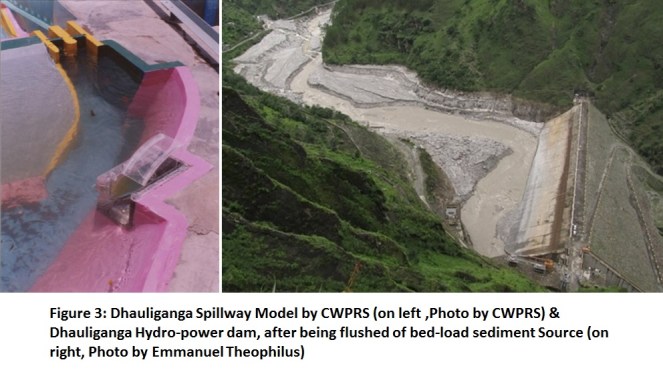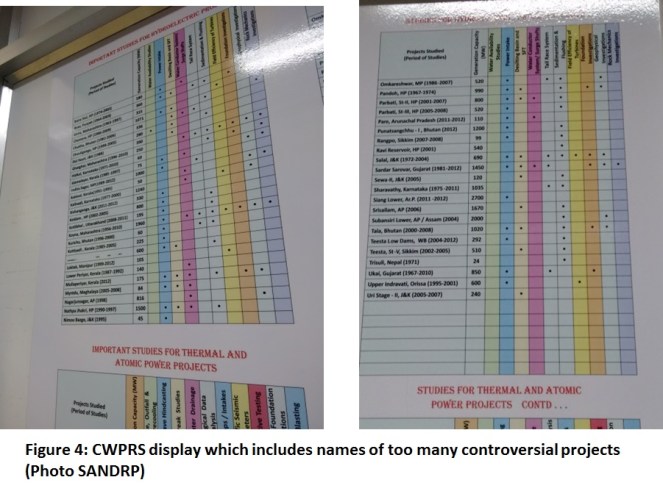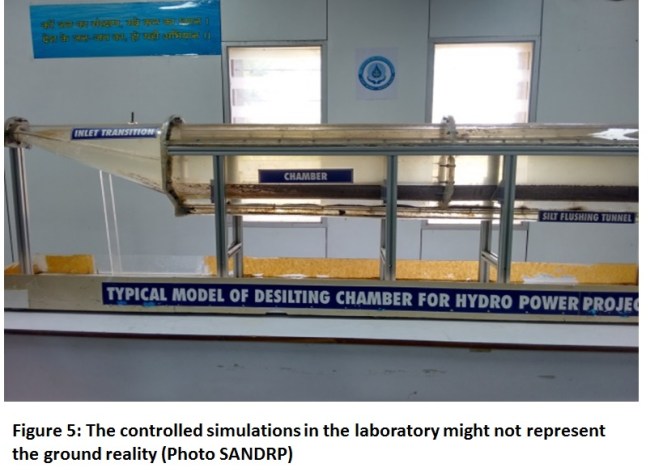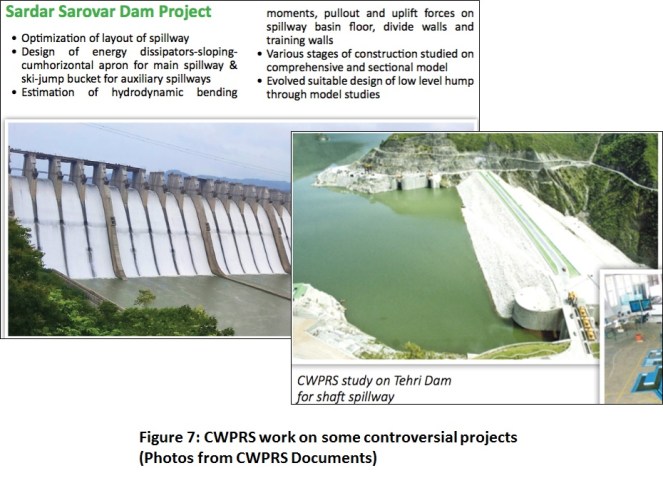Jawaharlal Nehru who famously celebrated large dams as “temples of modern India” later termed them as “disease of giganticism”.[i] The fascination wore out after witnessing the huge sacrifice of the vulnerable and unfulfilled promises. Government of India however has continued with the worship of giant structures such as big dams, ports, hydropower projects etc. Even after nearly seven decades of independence, ‘engineering approach’ still dominates the idea of river planning which views river as an entity to be engineered and planned for irrigation, hydropower, industrial and urban water use rather than as a living eco-system. 17 study models that were displayed at Central Water and Power Research Station (CWPRS) open house day at Khadakwasla near Pune on June 14, 2016, its completion of 100 years of existence, stood testimony to this.
CWPRS is a principle central agency under Union Ministry of Water Resources which looks at the R&D (Research & Development) needs of projects regarding water resources, energy and water-borne transport including coastal and harbour engineering. 17 out of 25 study models at the Khadakwasla campus of CWPRS located at about 16 km from Pune city were at display for general public, school children and engineering students on the occasion of open house day. The campus was flooded with people mainly school children.
Established in 1916 by the then Bombay Presidency as a “Special Irrigation Cell” with a mandate to modify irrigation practice to meet agricultural requirements CWPRS was taken over by the Government of India in 1936. It now holds a key position in the field of hydraulics and allied research.[ii] Giant entrance gateway of the campus makes a strong statement about this position.
To begin with, the predominant themes at the open house display which included river engineering, off-shore engineering, coastal engineering etc. stood in stark contrast with growing concerns about health and ecological integrity of river and coastal ecosystems. The study models which dealt mainly with flow hydraulics were devoid of important ecological elements such as riparian vegetation in case of rivers, mangroves in case of coasts. These are the elements which bring life to these ecosystems and also get impacted maximum with building of dams, diversions and hydropower projects and alterations in the flow. Absence of such key aspects seems to be one of the biggest limitations of these models. Mere water flow cannot be separated and studied in isolation from the geological and ecological aspects of surrounding region. In the entire CWPRS work, hydrology and flow of rivers is equated with water flow, but a flowing river also contains so many other things including silt, biota, nutrients to mention only a few.
These limitations were also evident in the displayed models. To give a small example the model for a bridge to be constructed on Narmada River as a part of Mumbai Vadodara Express Way was constructed without trace of riparian vegetation of the river which existed at the actual site. Small pieces of metal sheets seem to have been added as ‘grass’ (!!) as an afterthought to the model. Can such models represent the reality and be effective for providing sound solution? It might not be possible to accurately represent the reality, but even basic awareness and even the effort seems to be missing.


Similar is the case of Kosi River model which was used to simulate river flows for design of embankments by CWPRS. The Kosi river has shifted its course several times, by upto 112 km from 1731 to 1954. Using embankments for such a silt laden flood prone river seems rather an engineer’s arrogance. Kosi embankment project was completed in by Government of India in 1963 at the cost of 1500 Cr. with a barrage at Hanuman Nagar and marginal flood embankments on either side of the river both upstream and downstream to confine the river so as to prevent its tendency to shift its course periodically. However studies show that the instability of the river associated with sediment deposition has resulted in breaching of embankments on several occasions. In fact according to a study published in ‘Water & Energy International’ March 2011 issue[iii] 2008 floods of Kosi occurred at a discharge of only about 2830 cumecs which is only one tenth of the design flood discharge of about 28300 cumecs. Due to silt deposition river flow bifurcated in two branches within embankments and at the time of flooding left branch was carrying 80% of the incoming flow. Two spurs (designed to support embankment against the perpendicular thrust of the river flow) caused flow choking and instability resulting in wash out of the spurs and consequent breach of flood embankment even at such low flow.
While providing “hydraulically sound and economically viable”[iv] “solutions” to different projects, CWPRS seems to have disconnected from the larger environmental, socio-economic or climate change realities. Such “solutions” focused solely on water flow hydraulics might seem to be working in the controlled laboratory environment but often fail in reality since they cannot be isolated from complex riverine, environmental and social interactions. Not surprisingly the display boards at the exhibition hall contained several names of projects for which CWPRS has served as a technical agency, but are laden with serious technical, environmental and social issues. For example Dhauliganga Hydro Electric Project (HEP) in Uttarakhand for which CWPRS designed the dam spillway[v] caused devastating floods downstream in June 2013.[vi] Reservoir levels were already filled high with flood waters when blocking of the tail-race tunnel lead to flooding of the powerhouse. Hence the intake was shut off losing the option of reducing reservoir levels more gradually and safely through two simultaneous releases. The design of the Dhauliganga dam is such that there is no provision for water to ‘overflow’ the dam safely. The flood gates were suddenly opened without prior authorization to release the impounded water in the reservoir.

This is but one example. There are several other such hydro projects in CWPRS list which can be pointed out such as Kotlibhel 1A HEP in Uttarakhand, Dul-Hasti & Salal HEP in Jammu & Kashmir, Teesta St-V HEP in Sikkim, proposed Siang Lower HEP in Assam & Arunachal Pradesh etc. CWPRS also seems to have taken up inter-linking of canals and integration of rivers. Detailed Project Report (DPR) of Damanganga-Pinjal link project was prepared “with active support and co-operation of” CWPRS.[vii] Estimation of site-specific seismic parameters for Damanganga-Pinjal link as well as Par-Tapi link project have been conducted by CWPRS.[viii] River linking projects are being opposed by communities, states, civil society and environmental experts for the questionable justification, lack of scientific basis, neglected impacts and uncertain benefits.[ix] CWPRS also has also been an active participant of various studies conducted for inland water ways which can cause severe damage to rivers, river flood-plains with capital dredging and large-scale conversion of floodplain environments and riverbanks to concrete embankments.[x]
Many of these projects are cleared by Ministry of Environment based on inadequate Environmental Impact Assessment (EIA) and in some cases no EIAs. WAPCOS which is one of the partner agencies of CWPRS is well known for conducting poor quality environmental impact assessment and cumulative basin level impact assessment. The shoddy work of WAPCOS has been repeatedly highlighted by SANDRP.[xi]


I was curious about what is the CWPRS account on disconnect between the studies and their impacts. When I inquired about whom I should meet to find more about how CWPRS has evolved and its stand on the emerging opinion about viewing large dams and hydro projects as unviable options in the context of climate change; I was told at the outset by a lady official that “Your questions are such that no one is going to answer them. We have very strict policies about such matters.” She suggested that I meet the Joint Director. As expected his answer was “Environmental Impact Assessment (EIA) for the projects is not our mandate. We conduct flow studies focusing mainly on flow routing, how the flow will be affected, flood impact etc. Our studies form only a part of EIA.”
It is unfortunate that even after 100 years and witnessing too many disasters like Kosi floods in 2008 which breached the embankments, Uttarakhand floods in 2013, Jammu & Kashmir floods of Sept 2014 with disastrous the consequences on cities like Srinagar, Chennai Floods of Dec 2015 CWPRS is not ready to acknowledge the limitations of the engineering approach when dealing with rivers. Nor do they seem to take the responsibility of the too many shortcomings and on ground malfunctioning of the projects which they have been technical consultant to.



CWPRS is engaged for technical consultancy by apex agencies such as Central Water Commission. The institute receives significant funding from budgetary allocation. Total plan outlay for the XII plan which started from April 2012 was Rs.72 Crore. Out of which a provision of Rs.15.00 Crore is made for 2016-17.[xii]
Even on completion of 100 years, if an organization has no achievement to report, even after being funded by the World Bank under Hydrology Projects, questions are bound to arise. The World Bank is reported[xiii] to have done a benchmarking report (followed by a report of the committee of experts and a review committee report) for a number of organizations, including CWPRS and suggested future course of action, but those reports are under wraps! This CWPRS claim in their centenary celebration volume sounds more like a self trumpeting without much substance: “Just like a river acquires depth over time and contributes to making its surroundings lush and productive, the CWPRS has also grown from strength to strength over the hundred years of its existence.”
In fact all the project related studies done by CWPRS remain outside the public domain, so an independent assessment of the functioning and achievements of the organization is impossible. Even the studies done supposedly in public interest are not in public domain. For example, CWPRS is supposed to have done in 10th Five Year Plan a morphological study of Gandak river basin in the context of flood prone nature of the river.
In his centenary celebration message[xiv], Union Water Resources Secretary Shri Shashi Shekhar has rightly said: “CWPRS should also undertake systematic studies on River Rejuvenation for prioritizing actions for optimum results, dissemination of Traditional Water Wisdoms through development of appropriate models for upscaling and Disaster Management Planning.”
When asked about the impacts such projects cause on river health Joint Director of CWPRS claimed that “Yes now there is greater awareness about river. So we are also opening a new wing for river rejuvenation and also for revival of traditional water harvesting structures.” This seems like a welcome move by the organization following message from Shashi Shekhar ji, provided this concern pervades all the work CWPRS does and is not limited to lip service in a marginal project.
The need however seems to be entirely revisiting the approach towards surface water resources.
Amruta Pradhan, amrutapradhan@gmail.com, SANDRP
With inputs from Himanshu Thakkar
End Notes:
[i] Dams, Rivers & People (2006):
https://sandrp.in/drp/June2006.pdf, accessed June 18, 2016
[iii] https://sandrp.in/floods/SANDRP_submission_to_BiharKosiInquiryComn_March_09.pdf
[v] http://cwprs.gov.in/WriteReadData/file/onepage%20-%20water%20resources/DHAULIGANGA%20%20DAM%20SPILLWAY,%20UTTARANCHAL.pdf
[vi] https://sandrp.wordpress.com/2013/09/27/uttarakhand-floods-of-june-2013-curtain-raiser-on-the-events-at-nhpcs-280-mw-dhauliganga-hep/
[vii] http://nwda.gov.in/writereaddata/linkimages/2907293716.doc
[viii] http://cwprs.gov.in/WriteReadData/file/annual%20report/ar-11-12-eng.pdf
[ix] https://sandrp.wordpress.com/2014/05/19/interbasin-diversion-dams-in-western-ghats-unknown-impacts-and-uncertain-benefits/
[x] https://sandrp.wordpress.com/2016/02/19/digging-our-rivers-graves/
[xi] For example, see: i. https://sandrp.wordpress.com/2014/08/19/sach-khas-hydro-project-in-chenab-basin-another-example-of-wapcoss-shoddy-eia/, ii. https://sandrp.wordpress.com/2014/02/22/chinki-major-irrigation-project-on-narmada-yet-another-evidence-of-mps-obsession-with-large-irrigation-dams-wapcoss-shoddy-reports/, iii. https://sandrp.wordpress.com/2013/11/15/mohanpura-dam-in-madhya-pradesh/, iv. https://sandrp.wordpress.com/2013/11/12/bansujara-irrigation-project-in-mp/, v. https://sandrp.wordpress.com/2014/03/12/tragedy-of-errors-environmental-governance-and-the-sonthi-lift-irrigation-scheme/, vi. https://sandrp.wordpress.com/2014/01/15/critique-of-the-eia_emp-kalai-ii-hep/
[xii] http://wrmin.nic.in/writereaddata/OutcomeBudget_2016-17_Eng.pdf
[xiii] Annual report of Ministry of Water Resources for 2014-15, page 66
[xiv] http://cwprs.gov.in/WriteReadData/file/centenary_year/CWPRS%20CENTENARY%20BROUCHURE%20RELEASED%20BY%20FINANCE%20MINISTER.pdf

hits the nail head-on!
good article..
best ravi
LikeLike
There should be an independent and transparent expert audit of such Institutions lest our rivers continue to remain threatened from the so called modelling approvals from such institutions. How can you model nature with any sense of certainty. It is height of human arrogance!
LikeLike
If you really knew basics of modeling,this article would never have been written in first place.
I admire how you people call yourself experts of this field without even understanding that modeling cannot encompass all elements.
Even the best of supercomputers cannot do that.
The best perfect model my dear is the earth in itself.
I fear pseudo water experts like your organisation will lead to more chaos n confusion in this already complicated water sector.
LikeLike
Respected Sir,
You are conveniently reading what you want to. No one is saying the model should encompass all elements. But when the body work, including models, writings and other stuff is consistently on dimensional, than it raises questions, which is what is rasied.
SANDRP
LikeLike